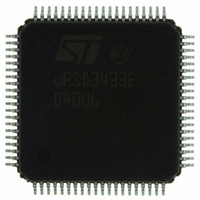UPSD3433EB40U6 STMicroelectronics, UPSD3433EB40U6 Datasheet - Page 145

UPSD3433EB40U6
Manufacturer Part Number
UPSD3433EB40U6
Description
MCU 8BIT 8032 128KB FLASH 80TQFP
Manufacturer
STMicroelectronics
Series
µPSDr
Datasheet
1.UPSD3434EB40T6.pdf
(293 pages)
Specifications of UPSD3433EB40U6
Core Processor
8032
Core Size
8-Bit
Speed
40MHz
Connectivity
I²C, IrDA, SPI, UART/USART, USB
Peripherals
LVD, POR, PWM, WDT
Number Of I /o
46
Program Memory Size
160KB (160K x 8)
Program Memory Type
FLASH
Ram Size
8K x 8
Voltage - Supply (vcc/vdd)
3 V ~ 5.5 V
Data Converters
A/D 8x10b
Oscillator Type
Internal
Operating Temperature
-40°C ~ 85°C
Package / Case
80-TQFP, 80-VQFP
For Use With
497-5518 - EVAL BOARD RFID READER497-5046 - KIT TOOL FOR ST7/UPSD/STR7 MCU
Lead Free Status / RoHS Status
Lead free / RoHS Compliant
Eeprom Size
-
Other names
497-5660
Available stocks
Company
Part Number
Manufacturer
Quantity
Price
Company:
Part Number:
UPSD3433EB40U6
Manufacturer:
STMicroelectronics
Quantity:
10 000
- Current page: 145 of 293
- Download datasheet (5Mb)
uPSD34xx
25.1.2
25.1.3
Endpoints
Each USB device contains a collection of independent endpoints, with an endpoint being the
destination of a communication flow between client software and the device. By design,
each USB device’s endpoints are given specific unique identifiers called endpoint numbers.
In addition, each endpoint has an associated direction for the data flow, either in (from
device to host) or out (from host to device). At the time a device is connected to the USB, it
is assigned a unique address. The combination of the device address, endpoint number,
and direction allows each endpoint to be uniquely referenced.
Each endpoint has some associated characteristics for the communication flow with the
client software running on the host. Those characteristics include:
●
●
●
●
●
●
●
All USB devices are required to implement a default control method that uses both the input
and output endpoints with Endpoint zero. The USB System Software uses this default
control method to initialize and generically manipulate the logical device as the Default
Control Pipe. Endpoint zero is always accessible and provides access to the device’s
configuration and status information as well as some basic control access.
Additional (non-zero) endpoints provide the communication flow required for the
functionality of the device. The non-zero endpoints are available for use only after the device
is configured per the normal device configuration process (see Chapter 9 of the USB
specification, http://www.usb.org).
Packets
USB transactions consist of data packets that contain special codes called Packet IDs
(PIDs). A PID signifies the kind of packet that is being transmitted. While there are more
types of PIDs in a USB system, the uPSD34xx responds to the three types shown in
Table 67
Table 67.
Figure 50
Token Packet with an OUT PID. The OUT PID indicates that the host is going to send data to
the addressed device’s endpoint. The ADDR field contains the address of the device and the
ENDP field contains the endpoint within the addressed device. The CRC5 is a Cyclic
Redundancy Check for error checking.
Token
Data
Handshake
Endpoint number;
Frequency and latency requirements;
Bandwidth requirements;
Maximum packet size capability;
Error handling requirements;
Data transfer direction; and
Transfer type.
shows an example of packets sent during a USB transfer. The first packet is a
PID Type
Types of packet IDs
IN, OUT, SETUP
DATA0, DATA1
ACK, NAK, STALL
PID Name
USB interface
145/293
Related parts for UPSD3433EB40U6
Image
Part Number
Description
Manufacturer
Datasheet
Request
R

Part Number:
Description:
MCU 8BIT 8032 128KB FLASH 80TQFP
Manufacturer:
STMicroelectronics
Datasheet:

Part Number:
Description:
MCU 8BIT 8032 128KB FLASH 52TQFP
Manufacturer:
STMicroelectronics
Datasheet:

Part Number:
Description:
STMicroelectronics [RIPPLE-CARRY BINARY COUNTER/DIVIDERS]
Manufacturer:
STMicroelectronics
Datasheet:

Part Number:
Description:
STMicroelectronics [LIQUID-CRYSTAL DISPLAY DRIVERS]
Manufacturer:
STMicroelectronics
Datasheet:

Part Number:
Description:
BOARD EVAL FOR MEMS SENSORS
Manufacturer:
STMicroelectronics
Datasheet:

Part Number:
Description:
NPN TRANSISTOR POWER MODULE
Manufacturer:
STMicroelectronics
Datasheet:

Part Number:
Description:
TURBOSWITCH ULTRA-FAST HIGH VOLTAGE DIODE
Manufacturer:
STMicroelectronics
Datasheet:

Part Number:
Description:
Manufacturer:
STMicroelectronics
Datasheet:

Part Number:
Description:
DIODE / SCR MODULE
Manufacturer:
STMicroelectronics
Datasheet:

Part Number:
Description:
DIODE / SCR MODULE
Manufacturer:
STMicroelectronics
Datasheet:

Part Number:
Description:
Search -----> STE16N100
Manufacturer:
STMicroelectronics
Datasheet:

Part Number:
Description:
Search ---> STE53NA50
Manufacturer:
STMicroelectronics
Datasheet:











